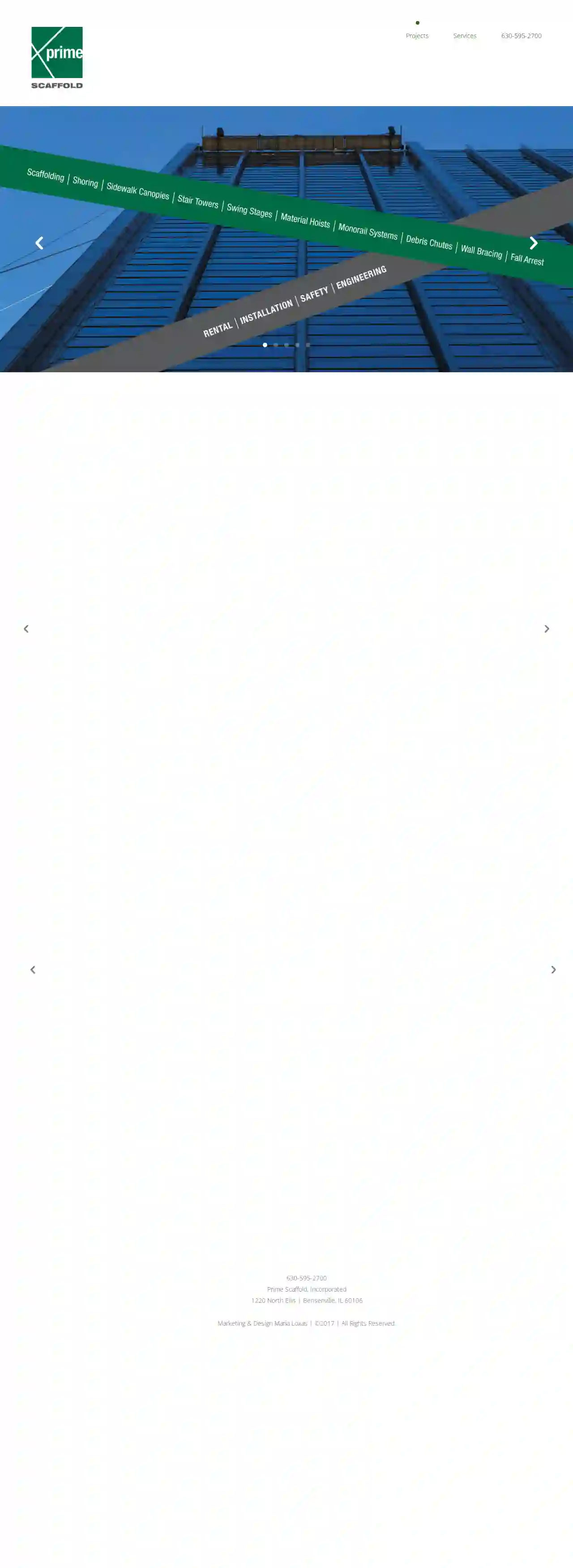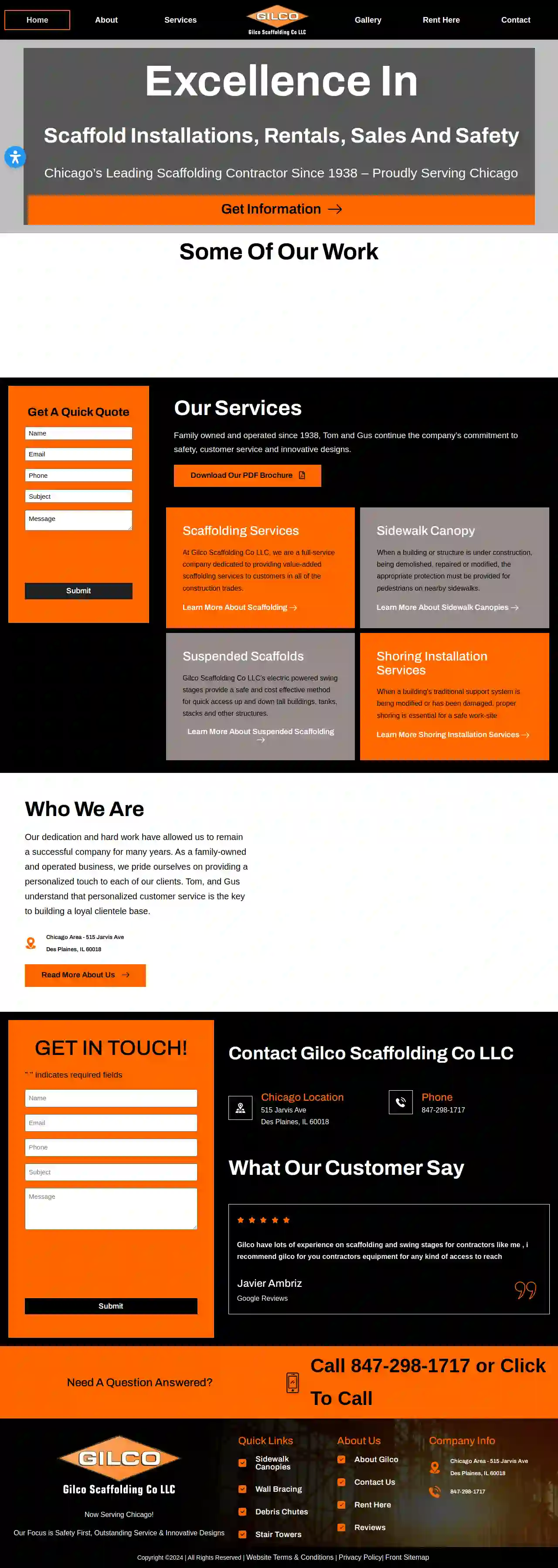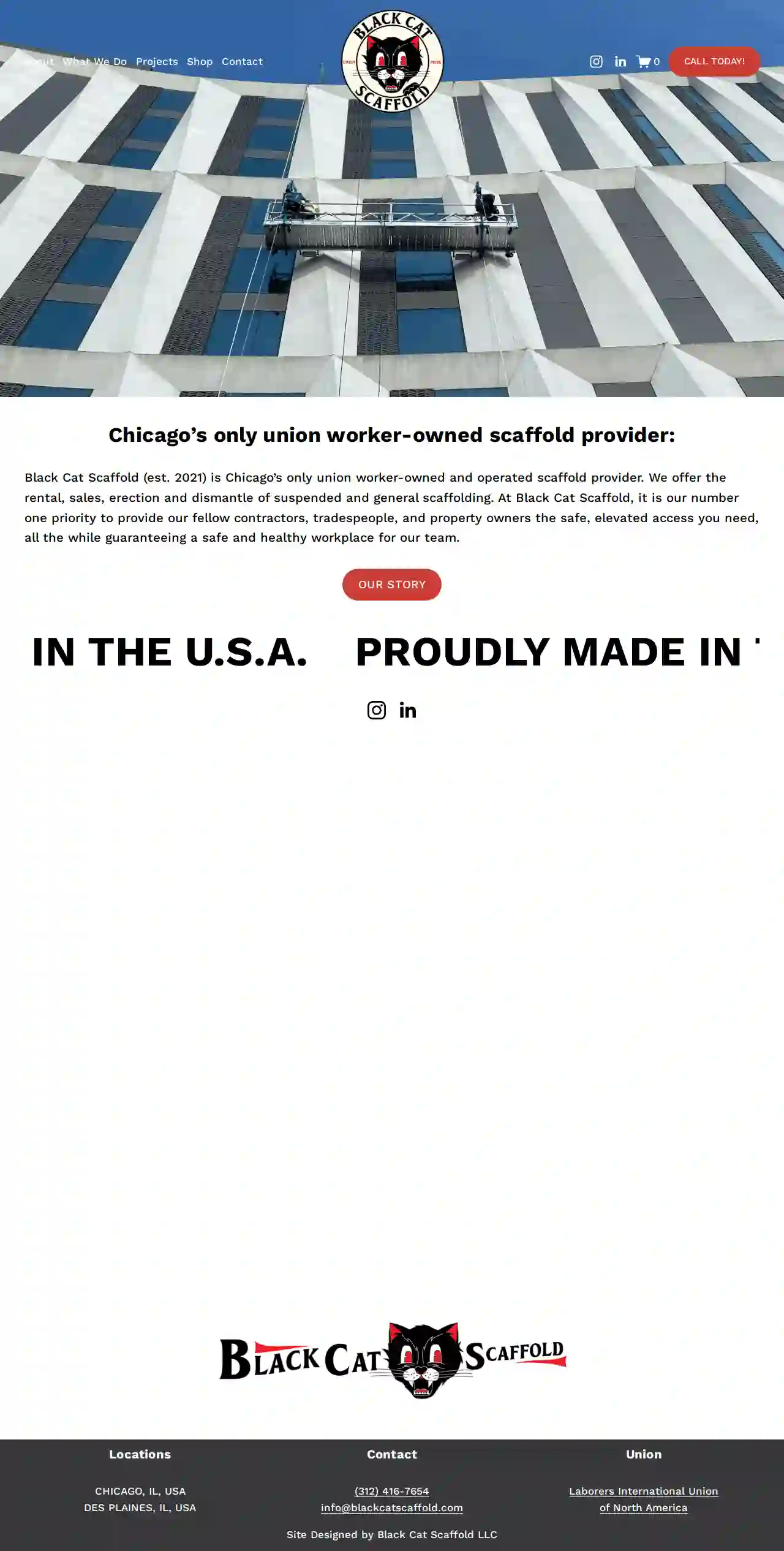Scaffolding Companies Woodridge
Top 10 Scaffolding Company in Woodridge
Get 3 FREE Scaffolding Experts quotes for your project today! Compare profiles, reviews, accreditations, portfolio, etc... and choose the best deal.

Prime Scaffold Inc
4.19 reviews1220 North Ellis, Bensenville, 60106, USPrime Scaffold has been planning, designing, engineering and installing scaffolding systems in the Chicago metropolitan area for over 35 years. With a team of fully engaged and well-trained installers, they provide innovation, attention to detail, safety and excellent customer service. Their expertise meets specific project needs, working on large and small projects for local buildings, museums, airports, ballparks, skyscrapers and famous landmarks. They are OSHA compliant and have experience with complex projects such as the Garfield Park Conservatory and 401 North Michigan Avenue.
- Services
- Why Us?
- Gallery
Get Quote
Chicago Scaffolding Inc.
4.331 reviewsChicago, Illinois, 4824 W. Lake Street, 60644, USChicago Scaffolding Inc. (CSI), family owned and operated since 1988, has a rich history of experience and a family tradition of hard work and dependability. CSI prides itself on the core belief of providing exceptional service, quality, and safety to all clients. With a strong commitment to long-term professional relationships, we prioritize 100% customer satisfaction.
- Services
- Why Us?
- Accreditations
- Our Team
- Testimonials
- Gallery
Get Quote
MVC Painting
4.976 reviews800 E Northwest Hwy, Suite 750, 800 E Northwest Hwy Suite 750, Palatine, 60074, USWelcome to MVC Painting, a full-service painting company with over 15 years of experience in making our client's home improvement dreams become a reality. Our team of skilled professionals is dedicated to providing high-quality workmanship and customer service. We offer a wide range of services, including interior/exterior painting, drywall installation and repair, power washing, and more. With 100% customer satisfaction guaranteed, you can rely on us to get it right the first time. We have 5-star ratings from hundreds of customers just like you.
- Services
- Why Us?
- Gallery
Get Quote
Gilco Scaffolding Co
3.316 reviews515 Jarvis Ave, Des Plaines, 60018, USExcellence In Scaffold Installations, Rentals, Sales And Safety Chicago’s Leading Scaffolding Contractor Since 1938 – Proudly Serving Chicago Our Services Family owned and operated since 1938, Tom and Gus continue the company’s commitment to safety, customer service and innovative designs. Scaffolding Services At Gilco Scaffolding Co LLC, we are a full-service company dedicated to providing value-added scaffolding services to customers in all of the construction trades. Who we are Our dedication and hard work have allowed us to remain a successful company for many years. As a family-owned and operated business, we pride ourselves on providing a personalized touch to each of our clients. Tom, and Gus understand that personalized customer service is the key to building a loyal clientele base.
- Services
- Why Us?
- Gallery
Get Quote
Black Cat Scaffold
52 reviewsChicago, USBlack Cat Scaffold (est. 2021) is Chicago’s first union worker-owned and operated scaffold provider offering the rental, sales, erection and dismantle of suspended and general scaffolding. At Black Cat Scaffold, it is our number one priority to provide our fellow contractors, tradespeople, and property owners the safe, elevated access you need, all the while guaranteeing a safe and healthy workplace for our team. As an American, minority-owned (MBE Certified), small business, we offer superior client focus and competitive pricing. Unlike most in our local industry, Black Cat Scaffold offers majority American-made swing stage and scaffold equipment through our US (Ohio) manufacturers. At Black Cat Scaffold it is our belief that when union laborers have ownership in the business they work for, they are able to provide top tier services and expertise. With a collective 25 years of experience in the Chicago Building Trades, this is our pledge to every client. Thank you for considering Black Cat Scaffold for your future access needs!
- Services
- Why Us?
- Accreditations
- Gallery
Get Quote
Bracing Systems Construction Supplies and Equipment
4.329 reviewsHanover Park, 4N350 Old Gary Ave, 60133, USWe understand your challenge: To get all your equipment and supplies reliably and on time, while maintaining good profit margins. As your most reliable source of construction equipment and contractor supplies, Bracing Systems can supply your company with the products to get your job done right and under budget. Whether you are a general contractor, masonry contractor, concrete contractor or a contractor in another specialized trade, we stock it for customer pick up or can deliver it right to the job site. Our service department has a huge inventory of parts in stock to repair your Lull, Mustang, JLG, Pettibone, or Manitou Forklift, Essick Mixer, Hydro-Mobile Scaffolding, Stihl Power Equipment, Multiquip Compactors /Troweling Machines and many more brands of construction equipment. We offer convenient customer pick up at our 2 suburban locations or excellent on time delivery to your jobsite.
- Services
- Why Us?
- Gallery
Get Quote
International Equipment Inc
25218 S State St, Crete, 60417, USInternational Equipment, Inc. is a leading supplier and installer of high-quality scaffold equipment that enables your crews to work productively and safely at heights. Wherever you need your scaffolding to take you International Equipment has the right equipment for your project. Servicing all of the Midwest, International Equipment responds quickly to the needs of our customers, even during emergencies. We are a devoted team committed to providing the right product for your project with a personal touch that many larger competitors cannot match. We offer designs in augmented or virtual reality as well as 3D allowing you to see your design as it will appear when installed. You won’t pay for estimator’s guess work or extra rental charges for equipment you don’t need. Parts lists and installation costs are accurate with our estimating systems. With our resources and extensive inventory of equipment we are able to provide you with a variety of options to buy or rent. From project planning and installation of equipment to rigorous safety standards and training, International Equipment is there for you from start to finish.
- Services
- Why Us?
- Gallery
Get Quote
SafwayAtlantic by BrandSafway - Chicago
4.19 reviewsChicago, IL, 123 Access Solutions Blvd, 60601, USBrandSafway is a leading provider of access solutions, including scaffolding, aerial work platforms, and forming and shoring equipment. With a strong commitment to safety, quality, and customer satisfaction, BrandSafway offers a wide range of services tailored to meet the unique needs of clients across various industries. Their team of experienced professionals works closely with clients to understand their requirements and deliver customized solutions that enhance efficiency and productivity. BrandSafway is dedicated to providing innovative access solutions that ensure safe and efficient project execution.
- Services
- Why Us?
- Accreditations
- Our Team
- Testimonials
Get Quote
Menards
4.2605 reviews123 Main St, CityName, 00000, USMenards is a leading home improvement store that offers a wide range of products and services to help customers enhance their homes. With a strong commitment to customer satisfaction, Menards strives to provide the best shopping experience possible. From building materials to home decor, Menards has everything you need to make your house a home.
- Services
- Why Us?
Get Quote
Walmart Supercenter
4.11404 S. Old Rand Rd, Lake Zurich, IL, 60047, USWalmart is a multinational retail corporation that operates a chain of hypermarkets, discount department stores, and grocery stores. With a strong commitment to providing quality products at affordable prices, Walmart aims to make everyday items accessible to everyone. The company's mission is to save people money so they can live better. Walmart offers a wide range of services including grocery shopping, electronics, home goods, and more. Their team consists of dedicated professionals who strive to provide excellent customer service. Walmart has multiple locations and serves various cities, ensuring convenience for customers across the country. They prioritize customer satisfaction and offer various trust factors such as a return policy, customer support, and a commitment to sustainability. Walmart also partners with various organizations to support local communities and promote environmental sustainability.
- Services
- Why Us?
- Accreditations
- Our Team
- Testimonials
- Gallery
Get Quote
Over 2,353+ Scaffolding Contractors on our directory
Our scaffolding pros operate in Woodridge and surrounding areas!
ScaffoldingHQ has curated and vetted the Best Scaffolding Businesses in Woodridge. Find a top & trustworthy business today.
Frequently Asked Questions About Scaffolding Companies
- A larger, more complex structure typically used for accessing multiple levels of a building.
- Offers greater height and versatility.
- Often used for construction, renovation, and maintenance.
- Smaller, portable platforms usually used for tasks at a single level.
- Commonly used for painting, plastering, or light repairs.
- Can be rolling or stationary.
- Experience: 'How long have you been in business, and what experience do you have with projects like mine?'
- Licensing and Insurance: 'Are you fully licensed and insured, and can I see proof of coverage?'
- Safety Record: 'What are your safety procedures, and how do you ensure worker safety on the job site?'
- References: 'Can you provide references from previous clients?'
- Quotes and Costs: 'Can you provide a detailed quote that outlines all costs, including materials, labor, and any additional services?'
- Project Timeline: 'What is the estimated timeframe for scaffolding erection and dismantling?'
- Communication: 'How will you communicate with me throughout the project?'
- Online Directories: Use specialized directories like ScaffoldingHQ to search for scaffolding companies in your area.
- Search Engines: Use Google or other search engines to search for 'scaffolding companies near me' or 'scaffolding rental [your location]'.
- Local Construction Associations: Contact local construction associations for recommendations.
- Word-of-Mouth Referrals: Ask friends, family, or colleagues for recommendations based on their past experiences.
- Tube and Clamp Scaffolding: A traditional and versatile system using individual tubes and clamps. It's highly adaptable but requires more time to erect.
- System Scaffolding: Pre-engineered systems with modular components that fit together quickly. They offer speed and efficiency, especially for larger projects.
- Suspended Scaffolding: Hung from a roof or overhead structure, ideal for high-rise buildings or areas with limited ground access.
- Mobile Scaffolding: Mounted on wheels, allowing easy movement around a worksite. Suitable for tasks like painting or plastering.
- Specialized Scaffolding: Cantilever scaffolding, rolling towers, and other specialized systems cater to specific needs.
What is the difference between scaffolding and staging?
Scaffolding:
What questions should I ask a scaffolding company before hiring them?
How can I find scaffolding companies near me?
What are the different types of scaffolding?
What is the difference between scaffolding and staging?
Scaffolding:
- A larger, more complex structure typically used for accessing multiple levels of a building.
- Offers greater height and versatility.
- Often used for construction, renovation, and maintenance.
- Smaller, portable platforms usually used for tasks at a single level.
- Commonly used for painting, plastering, or light repairs.
- Can be rolling or stationary.
What questions should I ask a scaffolding company before hiring them?
- Experience: 'How long have you been in business, and what experience do you have with projects like mine?'
- Licensing and Insurance: 'Are you fully licensed and insured, and can I see proof of coverage?'
- Safety Record: 'What are your safety procedures, and how do you ensure worker safety on the job site?'
- References: 'Can you provide references from previous clients?'
- Quotes and Costs: 'Can you provide a detailed quote that outlines all costs, including materials, labor, and any additional services?'
- Project Timeline: 'What is the estimated timeframe for scaffolding erection and dismantling?'
- Communication: 'How will you communicate with me throughout the project?'
How can I find scaffolding companies near me?
- Online Directories: Use specialized directories like ScaffoldingHQ to search for scaffolding companies in your area.
- Search Engines: Use Google or other search engines to search for 'scaffolding companies near me' or 'scaffolding rental [your location]'.
- Local Construction Associations: Contact local construction associations for recommendations.
- Word-of-Mouth Referrals: Ask friends, family, or colleagues for recommendations based on their past experiences.
What are the different types of scaffolding?
- Tube and Clamp Scaffolding: A traditional and versatile system using individual tubes and clamps. It's highly adaptable but requires more time to erect.
- System Scaffolding: Pre-engineered systems with modular components that fit together quickly. They offer speed and efficiency, especially for larger projects.
- Suspended Scaffolding: Hung from a roof or overhead structure, ideal for high-rise buildings or areas with limited ground access.
- Mobile Scaffolding: Mounted on wheels, allowing easy movement around a worksite. Suitable for tasks like painting or plastering.
- Specialized Scaffolding: Cantilever scaffolding, rolling towers, and other specialized systems cater to specific needs.